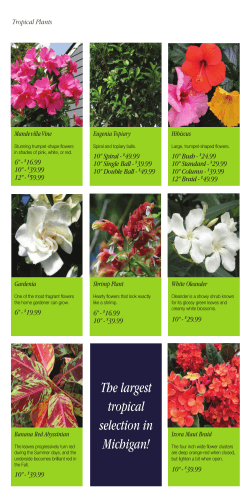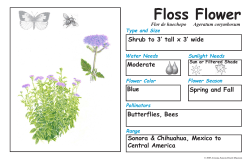
Nyssaceae
Nyssaceae Click to hear the pronunciation. Distribution Blackgum family Family with 5 genera about 100 species Distributed worldwide, mostly in temperate area, but some tropical and subtropical. Important members Nyssa – Tupelo Davidia – Dovetree Nyssaceae Nyssa sylvatica – Blackgum Black gum or tupelo is an exceptional native tree that can be used as a specimen tree, street tree or in naturalized areas. Trees have a glossy summer foliage and brilliant red fall color. Native from Maine to Florida, west to Texas, including Kentucky. The genus name refers to “Nyssa”, one of the water nymphs from Greek mythology who nursed the god Dionysis back to health. Click to hear the pronunciation. Nyssaceae Nyssa sylvatica – Blackgum Growth habit – Some plants have a strong central leader and have a pyramidal shape. Others show less apical dominance and have a rounded crown. Tree size – Tree size is between 40 and 50 feet, but can reach over 100 feet tall. Nyssaceae Nyssa sylvatica – Blackgum Individual trees can have either an upright pyramidal form or have a distinctly rounded form with drooping branches. Nyssaceae Nyssa sylvatica – Blackgum Flowers – Small, non-showy, greenish-white male and female flowers are produced on separate plants as the leaves emerge in the spring. Female flowers are on extended peduncles. Males are produced in a many-flowered cluster. Female flowers Male flowers Nyssaceae Nyssa sylvatica – Blackgum Females flowers are produced with up to 4 flowers per clusters. The style elongates from the center of each flower and the style is recurved. Female flowers Male flowers are produced in many-flowered umbel-like head. Each flower has 5 petals and stamens inserted into a central disk. Male flowers Nyssaceae Nyssa sylvatica – Blackgum Fruit – Fruits are a blue-black drupe with a calyx scar at the tip of the fruit. Nyssaceae Nyssa sylvatica – Blackgum Leaf – Simple, elliptically -shaped leaves are alternate on the stem. Summer color is a lustrous green. Nyssaceae Nyssa sylvatica – Blackgum Leaf – Autumn color is a brilliant glossy red. Nyssaceae Nyssa sylvatica – Blackgum Buds – Winter buds with imbricate (overlapping) scales. There are three leaf traces in the leaf scar. Leaf scar Nyssaceae Nyssa sylvatica – Blackgum Culture: Full sun. Prefers a moist, welldrained soil that is slightly acid. Blackgum can be difficult to transplant and it may be best to obtain container grown plants. Nyssaceae Nyssa sylvatica – Blackgum Culture: Leaf spot and foliar disease are common problems that can disfigure plants. Nyssaceae Nyssa sylvatica – Blackgum Cultivars: ‘Haymens’ is an upright growing tree with a strong central leader and clean foliage. Trees have very good fall color. Nyssaceae Nyssa sylvatica – Blackgum Cultivars: ‘Wild Fire’ is an interesting cultivar where the new emerging leaves are bright red. Nyssaceae Nyssa sylvatica – Blackgum Cultivars: ‘Pendula’ is available as a group of selections that are weeping with pendulous branches. Nyssaceae Nyssa sylvatica – Blackgum Cultivars: ‘Zydeco Twist’ is a unique cultivar with twisted branches. Nyssaceae Nyssa aquatica – Water tupelo Related species: Water tupelo is a southeastern North American relative to black gum that grows in swampy locations alongside bald cypress (Taxodium). Trees can reach 80 feet tall and are hardy in zones 9 to 6. Click to hear the pronunciation. Nyssaceae Nyssa sinensis – Chinese tupelo Related species: Chinese tupelo is native to China and can grow to 40 feet tall. Leaves are more pubescent that N. sylvatica. Not commonly available commercially. Hardy in zones 9 to 6. Click to hear the pronunciation. Nyssaceae Davidia involucrata – Dovetree Related species: Dovetree is an exceptional small tree that makes a wonderful specimen tree for residential as well as larger landscapes. Native to China and hardy in zones 7 to 5. The genus name commemorates Armand David, a French Jesuit missionary who was one of the first plant collectors in China in the 1860’s. Click to hear the pronunciation. Nyssaceae Davidia involucrata – Dovetree Growth habit – Trees with a strong central leader and a pyramidal habit when young growing to an irregular rounded shape with age. Tree size – Tree size grow to 20 and 40 feet with an equal spread. Nyssaceae Davidia involucrata – Dovetree Flowers – The flowers are produced in clusters between two showy asymmetrical white bracts that give the appearance of many handkerchiefs hanging in the tree. Nyssaceae Davidia involucrata – Dovetree Flowers – Dovetree is andro-monoecious producing all male and bisexual (male and female) flowers on the same tree in globose heads. Male flowers Bisexual flowers Stigma Stamens Stamens Nyssaceae Davidia involucrata – Dovetree Fruit – A single fruit is produced on a long pedicel. Fruit is an ovoid green drupe with reddish speckles. Nyssaceae Davidia involucrata – Dovetree Leaf – Simple, ovate-shaped leaves are alternate with a serrate leaf margin and up to to 5 inches long. No significant autumn color. Nyssaceae Davidia involucrata – Dovetree Culture: Trees do best in partial shade, but will tolerate full sun where summers are not too hot. Prefers a moist, welldrained soil that is slightly acid. Trees can be difficult to establish and suffer during drought conditions. Nyssaceae Davidia involucrata – Dovetree Cultivars: The common trees in cultivation are from the botanical variety vilmoriniana derived from the original China collection in 1897. ‘Sonoma’ is a clonal selection with very large bracts up to 10 inches in length. Since these are grafted plants, they start producing flowers as a small tree.
© Copyright 2025









